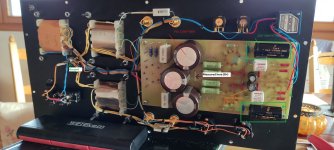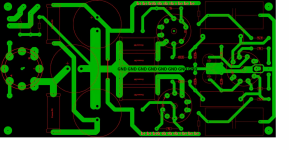Hi
I am trying to figure out what the B+ voltage is of my headphone tube amplifier, I am getting 180V seems low to me I've read that El84 tubes usually run with 300V plate voltage?
I measured at the jumper to get over the gnd line to bias the other side of the first input tube.
I'll attach some schematics and a picture and mark where I connected my multimeter.
Here is also an Imgur link with the images, it's telling me that the schematic file is too big to upload.
I am trying to figure out what the B+ voltage is of my headphone tube amplifier, I am getting 180V seems low to me I've read that El84 tubes usually run with 300V plate voltage?
I measured at the jumper to get over the gnd line to bias the other side of the first input tube.
I'll attach some schematics and a picture and mark where I connected my multimeter.
Here is also an Imgur link with the images, it's telling me that the schematic file is too big to upload.
Attachments
Last edited:
In a headphones amplifier the output power is modest compared to a normal amplifier. So a high B+ to achieve more power output is not nescessary there.
A B+ of 300 V for EL84 is fairly common in push-pull circuits but not so common for single ended circuits (there you mostly see a B+ of about 250 V; check the attached datasheets for the EL84.
Attached is an example of a Philips radio with an EL84 running in an single ended push-pull (SEPP) OTL configuration for 800 Ohm loudspeakers, with only 120 V between its anode and cathode.
So I would not worry much about a B+ of 180 V in your headphones amplifier.
A B+ of 300 V for EL84 is fairly common in push-pull circuits but not so common for single ended circuits (there you mostly see a B+ of about 250 V; check the attached datasheets for the EL84.
Attached is an example of a Philips radio with an EL84 running in an single ended push-pull (SEPP) OTL configuration for 800 Ohm loudspeakers, with only 120 V between its anode and cathode.
So I would not worry much about a B+ of 180 V in your headphones amplifier.
Attachments
Yoshimitsu,
That seems to me to be a very rare example of an actually good design for a headphone amplifier. Most lately stink on ice.So little output power is needed that everything can be biased for best linearity, and no concern taken for peak output power. Best linearity operating region for triodes is always in the high current, low anode voltage region just above (negative of) zero volts bias, and with the lightest possible loading. The output matching transformer is a welcome return to reality.
Sorry to be harsh, but most "tube headphone amps" are ridiculous. Yours is not. Classic designs worth considering are those for driving studio line levels of 0VU=+8dBm with 20dB headroom. None are as good as yours, but are the foundation. Following those vacuum valve classics were the Neve style semicon classics of the 0VU=+4dBm era, and yours is the post-modern version of those. Good genes.
All good fortune,
Chris
LTSpice confirms that yes, you can.

You could probably get away with using only the output tube, depending on the source and how much power do you need for the headphones.
You could probably get away with using only the output tube, depending on the source and how much power do you need for the headphones.
Last edited:
just use the EL86/6CW5 or 6P43P-E at half the load impedance, it'll give more power at similar THD.
I don't need more power, the amp has enough power to run 2x 600ohm headphones at the same time at a volume to burst your eardrums.just use the EL86/6CW5 or 6P43P-E at half the load impedance, it'll give more power at similar THD.
hey thanks amigo glad to hear this, I that that the guy who made this amp knows what he is doing, built a lot of guitar amps aswell for professional musicians.That seems to me to be a very rare example of an actually good design for a headphone amplifier. Most lately stink on ice.
And thanks everybody else for answering, my amp works just fine I was just concerned I somehow measured wrong.
I should be fine if I use 450V capacitors instead of the current 500V one for the rc filter?
- Home
- Amplifiers
- Tubes / Valves
- 180V B+ EL84 amplifier, is that plausible?

